Abstract
Several lines of evidence indicate that glycolysis is especially important for normal diastolic relaxation and for the maintenance of cellular ion homeostasis in myocardium. To elucidate whether the glycolytic flux of ATP contributes to diastolic tone and to the regulation of intracellular Ca2+, myocardial content of sugar phosphates ([SP]) and intracellular Ca2+ concentration ([Ca2+]i) were measured in isolated, perfused ferret hearts using nuclear magnetic resonance. Glucose and acetate were used as substrates for glycolysis and oxidative phosphorylation, respectively. Glycogen was effectively depleted after 15-min perfusion with glucagon (2 mg/liter), as verified by the lack of rise in [SP] during exposure to iodoacetate (100 microM) in substrate-free perfusate. Despite the fact that glycolytic flux had been blocked both by iodoacetate and by absence of substrate, end-diastolic left ventricular pressure (EDP) remained unchanged (P > 0.15, n = 6). The subsequent addition of glucose to the perfusate led to SP accumulation and a marked rise in EDP, with a significant correlation between EDP and [SP] (r = 0.86 +/- 0.04, P < 0.01, n = 6). A similar correlation was observed when glucose in the perfusate was replaced by 2-deoxyglucose (r = 0.78 +/- 0.09, P < 0.01, n = 3). Fluorine nuclear magnetic resonance measurements of [Ca2+]i verified that EDP faithfully reports changes in diastolic [Ca2+]i under the present experimental conditions. Thus, intracellular Ca2+ overload is caused by the accumulation of SP rather than by the inhibition of glycolysis per se. Glycolysis may appear to be important because its by-products are deleterious, and not necessarily because glycolytically derived ATP plays a favored role in ion homeostasis.
Full text
PDF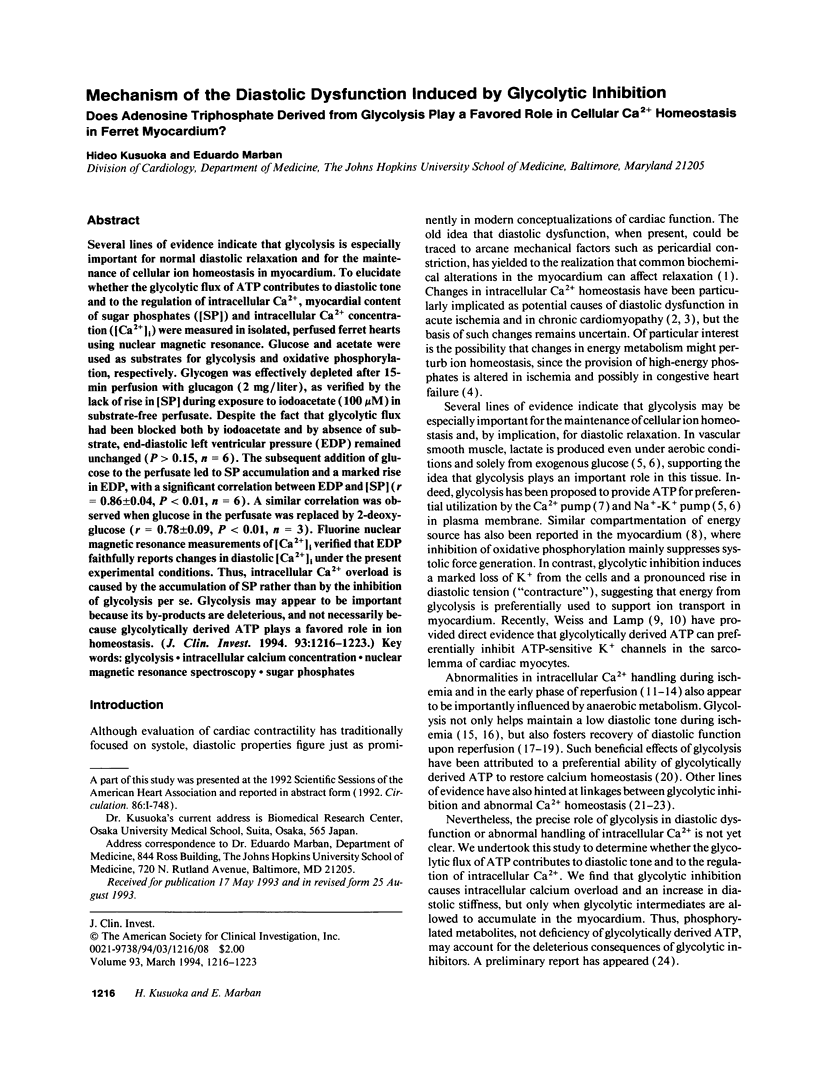
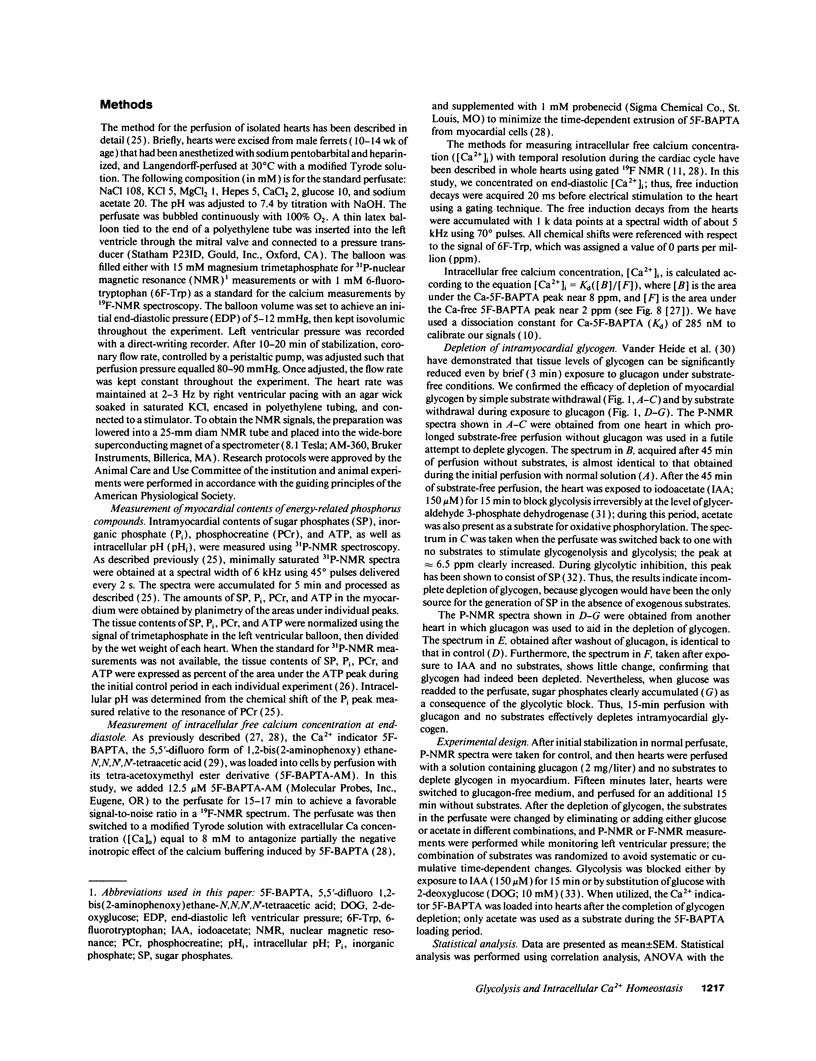
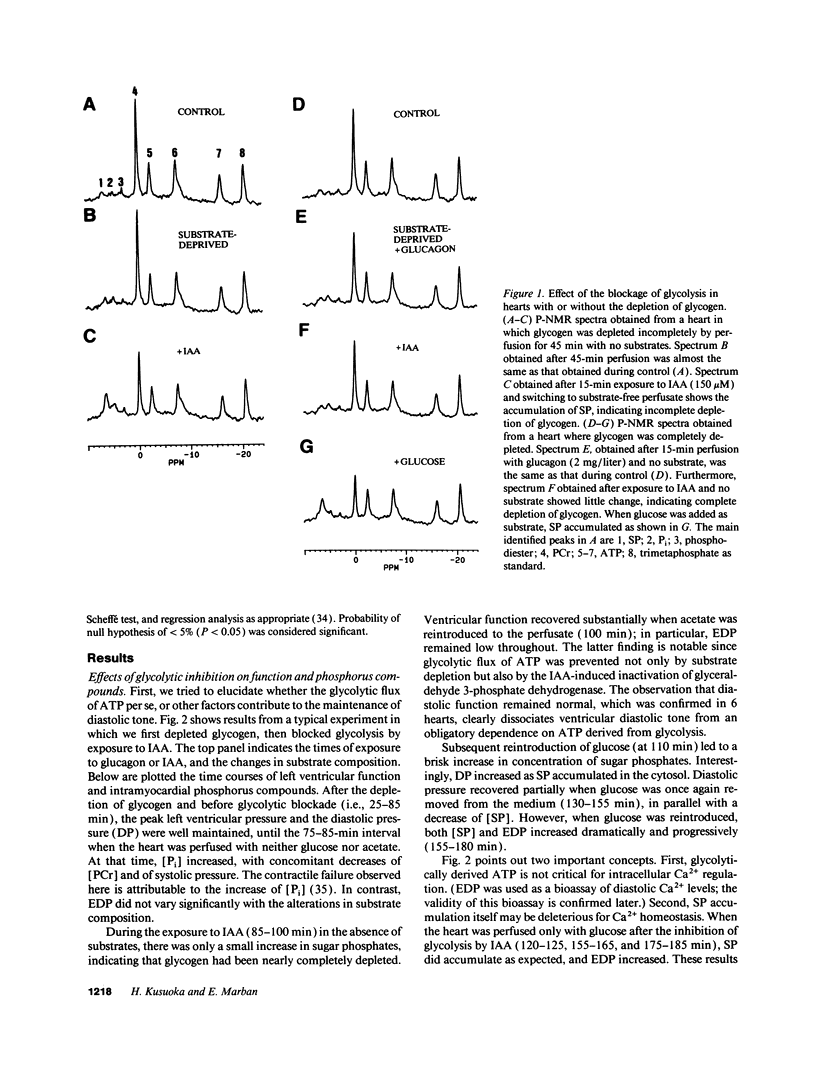
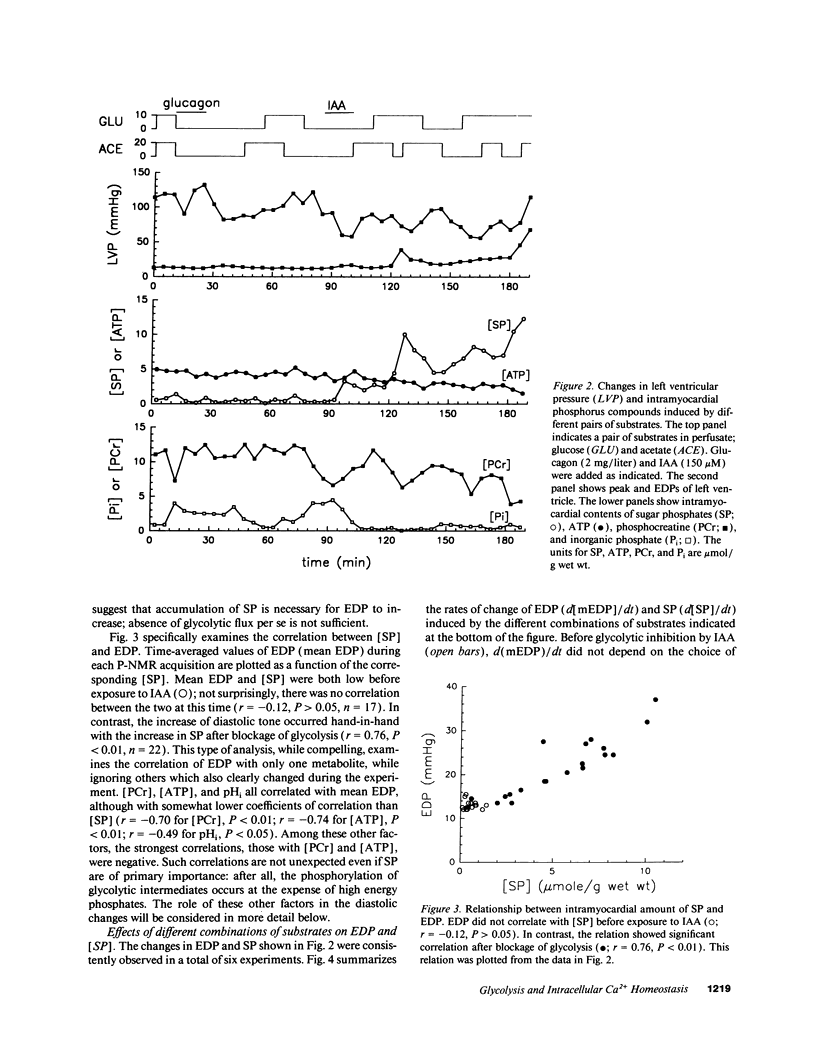
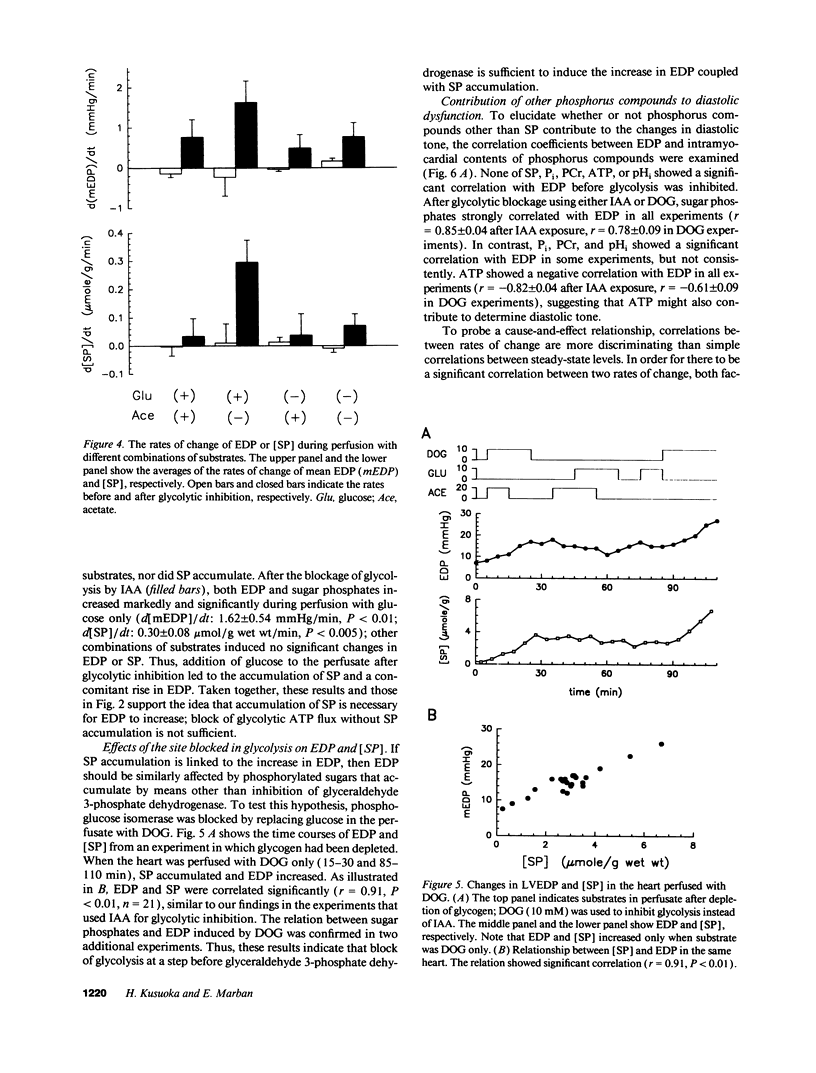
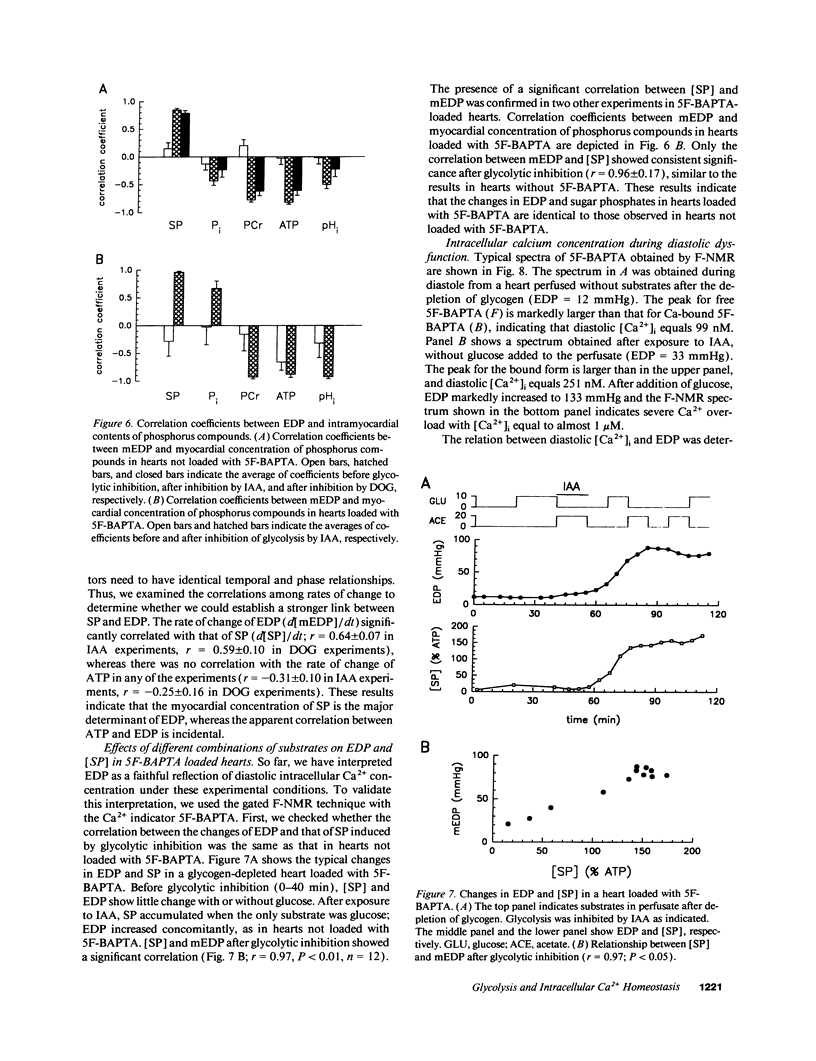
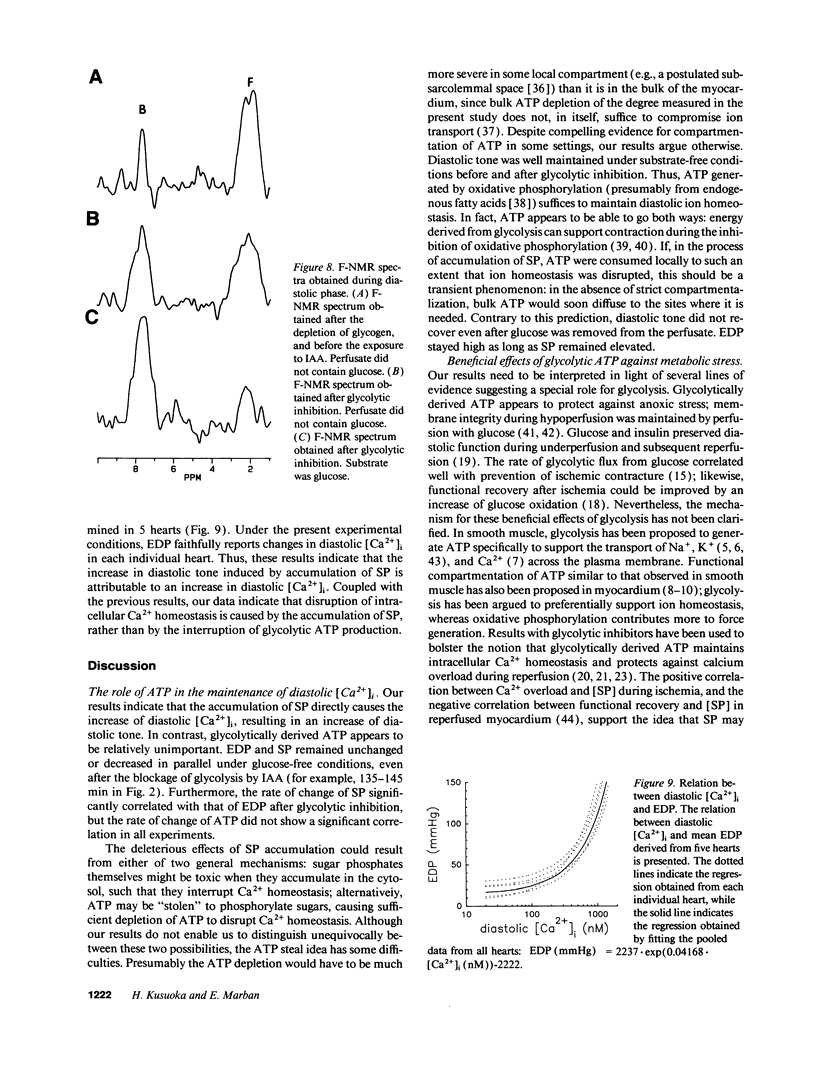
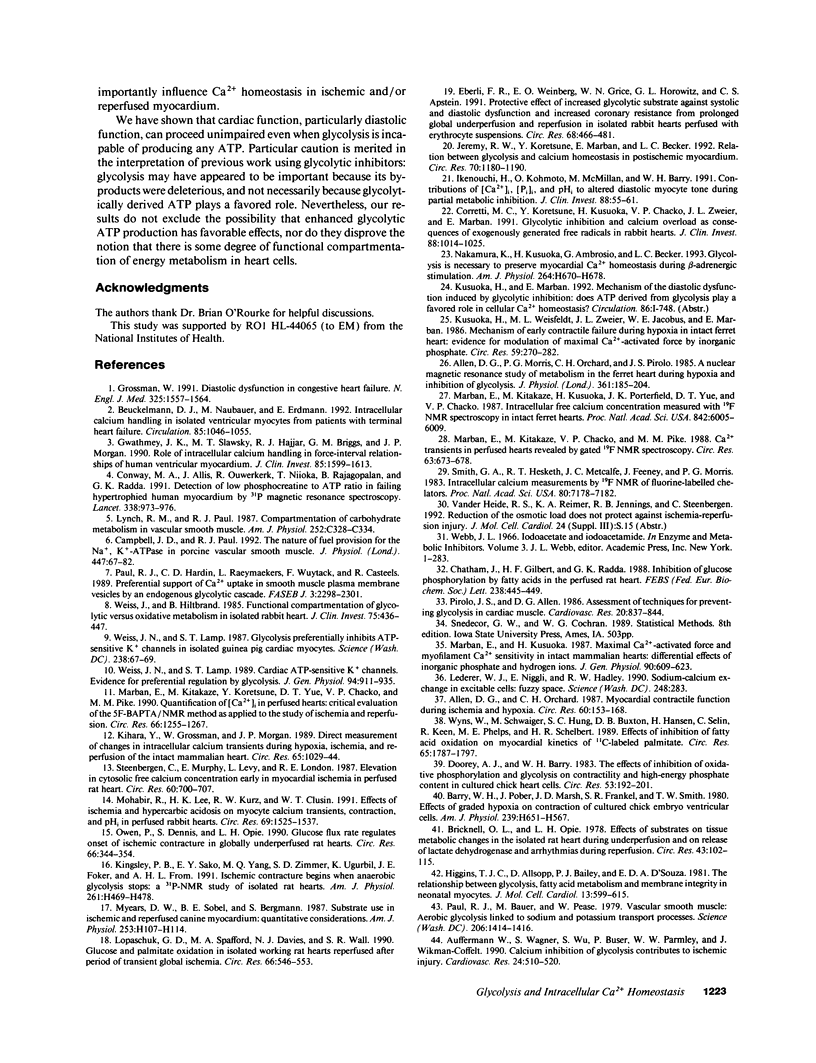
Selected References
These references are in PubMed. This may not be the complete list of references from this article.
- Allen D. G., Morris P. G., Orchard C. H., Pirolo J. S. A nuclear magnetic resonance study of metabolism in the ferret heart during hypoxia and inhibition of glycolysis. J Physiol. 1985 Apr;361:185–204. doi: 10.1113/jphysiol.1985.sp015640. [DOI] [PMC free article] [PubMed] [Google Scholar]
- Allen D. G., Orchard C. H. Myocardial contractile function during ischemia and hypoxia. Circ Res. 1987 Feb;60(2):153–168. doi: 10.1161/01.res.60.2.153. [DOI] [PubMed] [Google Scholar]
- Auffermann W., Wagner S., Wu S., Buser P., Parmley W. W., Wikman-Coffelt J. Calcium inhibition of glycolysis contributes to ischaemic injury. Cardiovasc Res. 1990 Jun;24(6):510–520. doi: 10.1093/cvr/24.6.510. [DOI] [PubMed] [Google Scholar]
- Beuckelmann D. J., Näbauer M., Erdmann E. Intracellular calcium handling in isolated ventricular myocytes from patients with terminal heart failure. Circulation. 1992 Mar;85(3):1046–1055. doi: 10.1161/01.cir.85.3.1046. [DOI] [PubMed] [Google Scholar]
- Bricknell O. L., Opie L. H. Effects of substrates on tissue metabolic changes in the isolated rat heart during underperfusion and on release of lactate dehydrogenase and arrhythmias during reperfusion. Circ Res. 1978 Jul;43(1):102–115. doi: 10.1161/01.res.43.1.102. [DOI] [PubMed] [Google Scholar]
- Campbell J. D., Paul R. J. The nature of fuel provision for the Na+,K(+)-ATPase in porcine vascular smooth muscle. J Physiol. 1992 Feb;447:67–82. doi: 10.1113/jphysiol.1992.sp018991. [DOI] [PMC free article] [PubMed] [Google Scholar]
- Chatham J., Gilbert H. F., Radda G. K. Inhibition of glucose phosphorylation by fatty acids in the perfused rat heart. FEBS Lett. 1988 Oct 10;238(2):445–449. doi: 10.1016/0014-5793(88)80529-5. [DOI] [PubMed] [Google Scholar]
- Conway M. A., Allis J., Ouwerkerk R., Niioka T., Rajagopalan B., Radda G. K. Detection of low phosphocreatine to ATP ratio in failing hypertrophied human myocardium by 31P magnetic resonance spectroscopy. Lancet. 1991 Oct 19;338(8773):973–976. doi: 10.1016/0140-6736(91)91838-l. [DOI] [PubMed] [Google Scholar]
- Corretti M. C., Koretsune Y., Kusuoka H., Chacko V. P., Zweier J. L., Marban E. Glycolytic inhibition and calcium overload as consequences of exogenously generated free radicals in rabbit hearts. J Clin Invest. 1991 Sep;88(3):1014–1025. doi: 10.1172/JCI115361. [DOI] [PMC free article] [PubMed] [Google Scholar]
- Doorey A. J., Barry W. H. The effects of inhibition of oxidative phosphorylation and glycolysis on contractility and high-energy phosphate content in cultured chick heart cells. Circ Res. 1983 Aug;53(2):192–201. doi: 10.1161/01.res.53.2.192. [DOI] [PubMed] [Google Scholar]
- Eberli F. R., Weinberg E. O., Grice W. N., Horowitz G. L., Apstein C. S. Protective effect of increased glycolytic substrate against systolic and diastolic dysfunction and increased coronary resistance from prolonged global underperfusion and reperfusion in isolated rabbit hearts perfused with erythrocyte suspensions. Circ Res. 1991 Feb;68(2):466–481. doi: 10.1161/01.res.68.2.466. [DOI] [PubMed] [Google Scholar]
- Grossman W. Diastolic dysfunction in congestive heart failure. N Engl J Med. 1991 Nov 28;325(22):1557–1564. doi: 10.1056/NEJM199111283252206. [DOI] [PubMed] [Google Scholar]
- Gwathmey J. K., Slawsky M. T., Hajjar R. J., Briggs G. M., Morgan J. P. Role of intracellular calcium handling in force-interval relationships of human ventricular myocardium. J Clin Invest. 1990 May;85(5):1599–1613. doi: 10.1172/JCI114611. [DOI] [PMC free article] [PubMed] [Google Scholar]
- Higgins T. J., Allsopp D., Bailey P. J., D'Souza E. D. The relationship between glycolysis, fatty acid metabolism and membrane integrity in neonatal myocytes. J Mol Cell Cardiol. 1981 Jun;13(6):599–615. doi: 10.1016/0022-2828(81)90330-8. [DOI] [PubMed] [Google Scholar]
- Ikenouchi H., Kohmoto O., McMillan M., Barry W. H. Contributions of [Ca2+]i, [Pi]i, and pHi to altered diastolic myocyte tone during partial metabolic inhibition. J Clin Invest. 1991 Jul;88(1):55–61. doi: 10.1172/JCI115304. [DOI] [PMC free article] [PubMed] [Google Scholar]
- Jeremy R. W., Koretsune Y., Marban E., Becker L. C. Relation between glycolysis and calcium homeostasis in postischemic myocardium. Circ Res. 1992 Jun;70(6):1180–1190. doi: 10.1161/01.res.70.6.1180. [DOI] [PubMed] [Google Scholar]
- Kihara Y., Grossman W., Morgan J. P. Direct measurement of changes in intracellular calcium transients during hypoxia, ischemia, and reperfusion of the intact mammalian heart. Circ Res. 1989 Oct;65(4):1029–1044. doi: 10.1161/01.res.65.4.1029. [DOI] [PubMed] [Google Scholar]
- Kingsley P. B., Sako E. Y., Yang M. Q., Zimmer S. D., Ugurbil K., Foker J. E., From A. H. Ischemic contracture begins when anaerobic glycolysis stops: a 31P-NMR study of isolated rat hearts. Am J Physiol. 1991 Aug;261(2 Pt 2):H469–H478. doi: 10.1152/ajpheart.1991.261.2.H469. [DOI] [PubMed] [Google Scholar]
- Kusuoka H., Weisfeldt M. L., Zweier J. L., Jacobus W. E., Marban E. Mechanism of early contractile failure during hypoxia in intact ferret heart: evidence for modulation of maximal Ca2+-activated force by inorganic phosphate. Circ Res. 1986 Sep;59(3):270–282. doi: 10.1161/01.res.59.3.270. [DOI] [PubMed] [Google Scholar]
- Lederer W. J., Niggli E., Hadley R. W. Sodium-calcium exchange in excitable cells: fuzzy space. Science. 1990 Apr 20;248(4953):283–283. doi: 10.1126/science.2326638. [DOI] [PubMed] [Google Scholar]
- Lopaschuk G. D., Spafford M. A., Davies N. J., Wall S. R. Glucose and palmitate oxidation in isolated working rat hearts reperfused after a period of transient global ischemia. Circ Res. 1990 Feb;66(2):546–553. doi: 10.1161/01.res.66.2.546. [DOI] [PubMed] [Google Scholar]
- Lynch R. M., Paul R. J. Compartmentation of carbohydrate metabolism in vascular smooth muscle. Am J Physiol. 1987 Mar;252(3 Pt 1):C328–C334. doi: 10.1152/ajpcell.1987.252.3.C328. [DOI] [PubMed] [Google Scholar]
- Marban E., Kitakaze M., Chacko V. P., Pike M. M. Ca2+ transients in perfused hearts revealed by gated 19F NMR spectroscopy. Circ Res. 1988 Sep;63(3):673–678. doi: 10.1161/01.res.63.3.673. [DOI] [PubMed] [Google Scholar]
- Marban E., Kitakaze M., Koretsune Y., Yue D. T., Chacko V. P., Pike M. M. Quantification of [Ca2+]i in perfused hearts. Critical evaluation of the 5F-BAPTA and nuclear magnetic resonance method as applied to the study of ischemia and reperfusion. Circ Res. 1990 May;66(5):1255–1267. doi: 10.1161/01.res.66.5.1255. [DOI] [PubMed] [Google Scholar]
- Marban E., Kitakaze M., Kusuoka H., Porterfield J. K., Yue D. T., Chacko V. P. Intracellular free calcium concentration measured with 19F NMR spectroscopy in intact ferret hearts. Proc Natl Acad Sci U S A. 1987 Aug;84(16):6005–6009. doi: 10.1073/pnas.84.16.6005. [DOI] [PMC free article] [PubMed] [Google Scholar]
- Marban E., Kusuoka H. Maximal Ca2+-activated force and myofilament Ca2+ sensitivity in intact mammalian hearts. Differential effects of inorganic phosphate and hydrogen ions. J Gen Physiol. 1987 Nov;90(5):609–623. doi: 10.1085/jgp.90.5.609. [DOI] [PMC free article] [PubMed] [Google Scholar]
- Mohabir R., Lee H. C., Kurz R. W., Clusin W. T. Effects of ischemia and hypercarbic acidosis on myocyte calcium transients, contraction, and pHi in perfused rabbit hearts. Circ Res. 1991 Dec;69(6):1525–1537. doi: 10.1161/01.res.69.6.1525. [DOI] [PubMed] [Google Scholar]
- Nakamura K., Kusuoka H., Ambrosio G., Becker L. C. Glycolysis is necessary to preserve myocardial Ca2+ homeostasis during beta-adrenergic stimulation. Am J Physiol. 1993 Mar;264(3 Pt 2):H670–H678. doi: 10.1152/ajpheart.1993.264.3.H670. [DOI] [PubMed] [Google Scholar]
- Owen P., Dennis S., Opie L. H. Glucose flux rate regulates onset of ischemic contracture in globally underperfused rat hearts. Circ Res. 1990 Feb;66(2):344–354. doi: 10.1161/01.res.66.2.344. [DOI] [PubMed] [Google Scholar]
- Paul R. J., Bauer M., Pease W. Vascular smooth muscle: aerobic glycolysis linked to sodium and potassium transport processes. Science. 1979 Dec 21;206(4425):1414–1416. doi: 10.1126/science.505014. [DOI] [PubMed] [Google Scholar]
- Paul R. J., Hardin C. D., Raeymaekers L., Wuytack F., Casteels R. Preferential support of Ca2+ uptake in smooth muscle plasma membrane vesicles by an endogenous glycolytic cascade. FASEB J. 1989 Sep;3(11):2298–2301. doi: 10.1096/fasebj.3.11.2528493. [DOI] [PubMed] [Google Scholar]
- Pirolo J. S., Allen D. G. Assessment of techniques for preventing glycolysis in cardiac muscle. Cardiovasc Res. 1986 Nov;20(11):837–844. doi: 10.1093/cvr/20.11.837. [DOI] [PubMed] [Google Scholar]
- Smith G. A., Hesketh R. T., Metcalfe J. C., Feeney J., Morris P. G. Intracellular calcium measurements by 19F NMR of fluorine-labeled chelators. Proc Natl Acad Sci U S A. 1983 Dec;80(23):7178–7182. doi: 10.1073/pnas.80.23.7178. [DOI] [PMC free article] [PubMed] [Google Scholar]
- Steenbergen C., Murphy E., Levy L., London R. E. Elevation in cytosolic free calcium concentration early in myocardial ischemia in perfused rat heart. Circ Res. 1987 May;60(5):700–707. doi: 10.1161/01.res.60.5.700. [DOI] [PubMed] [Google Scholar]
- Weiss J. N., Lamp S. T. Cardiac ATP-sensitive K+ channels. Evidence for preferential regulation by glycolysis. J Gen Physiol. 1989 Nov;94(5):911–935. doi: 10.1085/jgp.94.5.911. [DOI] [PMC free article] [PubMed] [Google Scholar]
- Weiss J. N., Lamp S. T. Glycolysis preferentially inhibits ATP-sensitive K+ channels in isolated guinea pig cardiac myocytes. Science. 1987 Oct 2;238(4823):67–69. doi: 10.1126/science.2443972. [DOI] [PubMed] [Google Scholar]
- Weiss J., Hiltbrand B. Functional compartmentation of glycolytic versus oxidative metabolism in isolated rabbit heart. J Clin Invest. 1985 Feb;75(2):436–447. doi: 10.1172/JCI111718. [DOI] [PMC free article] [PubMed] [Google Scholar]
- Wyns W., Schwaiger M., Huang S. C., Buxton D. B., Hansen H., Selin C., Keen R., Phelps M. E., Schelbert H. R. Effects of inhibition of fatty acid oxidation on myocardial kinetics of 11C-labeled palmitate. Circ Res. 1989 Dec;65(6):1787–1797. doi: 10.1161/01.res.65.6.1787. [DOI] [PubMed] [Google Scholar]


